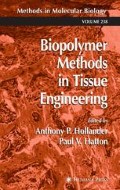Abstract
Examination of engineered tissues is clearly necessary to evaluate their properties and determine how close they are to those of the original tissue being engineered. Microscopy encompasses a group of techniques that allows the assessment of many parameters, including information on the cells themselves, on their viability, density, proliferation status, morphology, their capacity for protein synthesis, and their cell activity. Microscopy can also be utilized to follow the structure of any scaffold used and to determine whether it is broken down. In addition to examining how the cells interact with it, the scaffold can be examined to establish whether they adhere successfully, which molecules are involved, and whether the cells go on to produce any matrix—and if so, whether it replaces the original scaffold or integrates with it and builds on it.
Access this chapter
Tax calculation will be finalised at checkout
Purchases are for personal use only
References
Bancroft, J.D. and Cook, H.C., eds. (1994)Manual of Histological Techniques and their Diagnostic Application. Churchill Livingstone, Edinburgh, UK.
Bancroft, J. D. and Stevens, A., eds. (1982) Theory and Practice of Histological Techniques. 2nd ed. Churchill Livingstone, Edinburgh, UK.
Durrant, I. and Cunningham, M. (1995) Synthesis of riboprobes, in Gene Probes 1. A Practical Approach (Hames, B. D. and Higgins, S. J., eds.), Oxford University Press, pp. 190–210.
Decimo, D., Georges-Labouesse, E., and Dollé, P. (1995) In situ hybridisation of nucleic acid probes to cellular RNA, in Gene Probes 2. A Practical Approach. (Hames, B. D. and Higgins, S. J., eds.), Oxford University Press, pp. 183–210.
Russ J.C., ed. (1994) The Image Processing Handbook. 2nd ed. CRC Press, Boca Raton, FL.
Barker, N. J., Zahurak, M., Olsen, J. L., Nadasdy, T., Racusen, L.C., and Hrusan, R. H. (1998) Digital imaging of black and white photomicrographs. Am. J. Surg. Path. 22, 1411–1416.
Bradbury, S. (1990) Photomicrography, in In Situ Hybridization: Principles and Practice (Polak, J. M. and McGee, J. O’D., eds.), Oxford University Press. Oxford, UK.
Cruz-Orive, L. M. and Weibel, E. R. (1990) Recent stereological methods for cell biology: a brief survey. Am. J. Physiol. 258, L148–L156.
Ashton, I. K., Roberts, S., Jaffray, D. C., Polak, J. M., and Eisenstein, S. M. (1994) Neuropeptides in the human intervertebral disc. J. Orthop. Res. 12, 186–192.
Hunziker, E. B., Ludi, A., and Herrmann, W. (1992) Preservation of cartilage matrix proteoglycans using cationic dyes chemically related to ruthenium hexaammine trichloride. J. Histochem. Cytochem. 40, 909–917.
Scott, J. E. and Dorling, J. (1965) Differential Staining of Acid Glycosaminoglycans (mucopolysaccharides) by Alcian Blue in Salt Solutions. Histochemistry 5, 221–233.
Gray, D. W. R. and Morris, P. J. (1987) The use of fluoroscein diacetate and ethidium bromide as a viability stain for isolated islets of langerhans. Stain Techn. 62, 373–381.
Author information
Authors and Affiliations
Editor information
Editors and Affiliations
Rights and permissions
Copyright information
© 2004 Humana Press Inc.
About this protocol
Cite this protocol
Roberts, S., Menage, J. (2004). Microscopic Methods for the Analysis of Engineered Tissues. In: Hollander, A.P., Hatton, P.V. (eds) Biopolymer Methods in Tissue Engineering. Methods in Molecular Biology™, vol 238. Humana Press. https://doi.org/10.1385/1-59259-428-X:171
Download citation
DOI: https://doi.org/10.1385/1-59259-428-X:171
Publisher Name: Humana Press
Print ISBN: 978-0-89603-967-4
Online ISBN: 978-1-59259-428-3
eBook Packages: Springer Protocols

